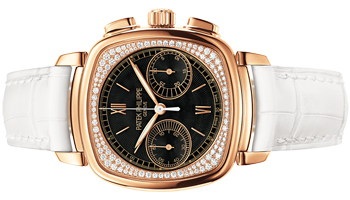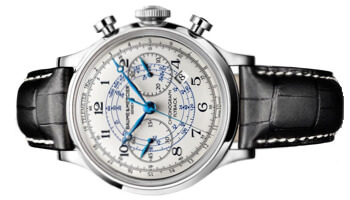Chronograph
A chronograph is a complication that describes the timing functionality of a timepiece, known more commonly as a stopwatch. It allows the wearer to measure intervals of time without affecting the normal time-telling function of the watch. The chronograph changed the world because it allowed for incredible accuracy in recording time — from 1/100 of a second up to 12 hours. While the basic idea of a chronograph is the same from watch to watch, there are three different types of chronographs that exist in watches today.
Simple Chronograph
The standard chronograph is controlled by either one or two buttons (also referred to as “pushers”) that allow it to start, stop and reset. While all early chronographs featured only one button, most of today’s timepieces utilize either one or two pushers. Its innumerable uses make it a common and desirable complication.
Patek Philippe Ladies First Chronograph
Flyback Chronograph
The flyback chronograph is an advanced chronograph that enables the rapid restarting of the timer function while the chronograph is running. When the chronograph button is pushed, the chronograph will stop, reset to zero and restart. This fast return feature is often times needed for split second accuracy.
Baume & Mercier Capeland 10006
Rattrapante Chronograph
The French word for “split seconds,” rattrapante describes an additional complication within a chronograph. The rattrapante chronograph features an additional second hand that is superimposed on the chronograph hand and enables the measurement of multiple events occurring simultaneously.






